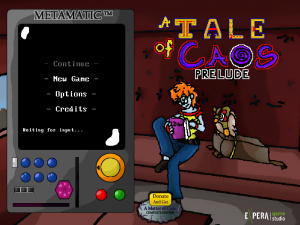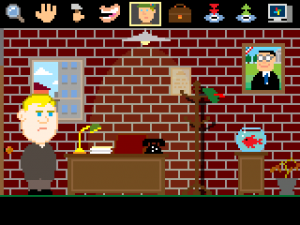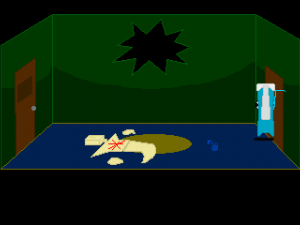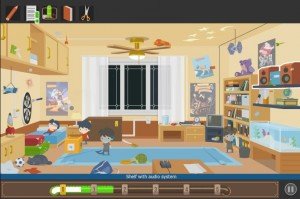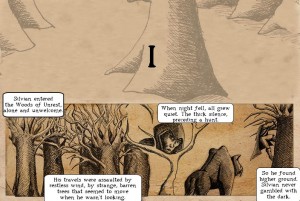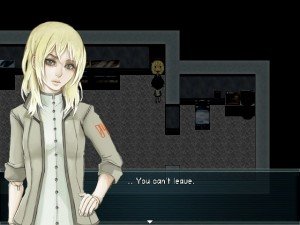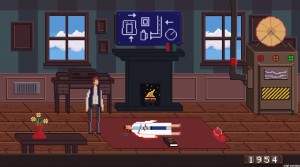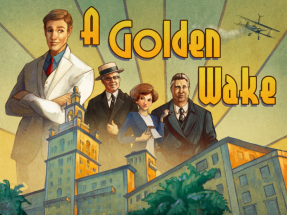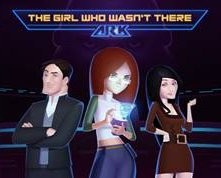Following Freeware - July 2015 releases
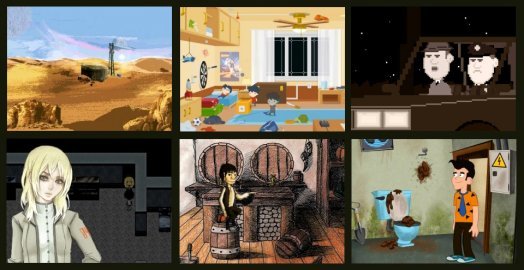
This month you can play a boy searching for his identity, a young woman seeking an apprenticeship, or someone who looks like a fridge. You can also time travel across the span of 150 years or loop repeatedly through a period of only 5 minutes. Investigators can look into the death of a pipe-maker, or seek out the horrible truth behind events on a spaceship. Alternatively, you might play a robot involved in creating a TV show, a man turning a toilet into an art gallery, or a fantasy adventurer in well over his head. All these await you in this month’s round-up of releases from the freeware scene.
Willem's Winners
A Tale of Caos: Prologue
When we meet Terry for the first time, she is in a carriage on her way to the technomancer Albion McMaster’s house, where she hopes to become his apprentice. She will show all the masters who threw her out what she is made of, oh yes! She has heard that McMaster lives a very secluded life in his castle and lets nobody in, so after arriving she must find an alternative way to enter. Surprisingly, McMaster turns out to be a friendly man, and gives her a task that, when completed successfully, will make her worthy of being his apprentice. Together with the automaton owl Heimlich which Terry made long ago, she goes on her appointed quest through the lands surrounding the castle in search of three very special objects.
 A Tale of Caos: Prologue is the first installment of a new series by ExperaGameStudio, the makers of the brilliant four-part A Matter of Caos. This spinoff looks very different from their other games though. The world is shown in third-person mode in beautiful bright colors, in stark contrast to the largely black-and-white presentation of the other games. Despite its highly pixelated display, everything of importance is clearly visible here. Terry has to visit a fairly large number of main locations for such a small game, such as a boring forest, a swamp and the castle’s garden. Each of these locales consists of a few screens, and there is not one scene in which there is nothing to do. The gameplay is accompanied by cheerful music that changes depending on the current location. There are also a great many convincing sound effects, like the breaking of branches, big explosions, the roaring of animals and many more. The game does not contain voices, however; everything spoken is shown in small but readable letters on screen. The letters perhaps need to be small because Terry and the other characters often use lots of words to say simple things. The dialogues are sprinkled with little jokes and here and there you find references to other adventure games and movies.
A Tale of Caos: Prologue is the first installment of a new series by ExperaGameStudio, the makers of the brilliant four-part A Matter of Caos. This spinoff looks very different from their other games though. The world is shown in third-person mode in beautiful bright colors, in stark contrast to the largely black-and-white presentation of the other games. Despite its highly pixelated display, everything of importance is clearly visible here. Terry has to visit a fairly large number of main locations for such a small game, such as a boring forest, a swamp and the castle’s garden. Each of these locales consists of a few screens, and there is not one scene in which there is nothing to do. The gameplay is accompanied by cheerful music that changes depending on the current location. There are also a great many convincing sound effects, like the breaking of branches, big explosions, the roaring of animals and many more. The game does not contain voices, however; everything spoken is shown in small but readable letters on screen. The letters perhaps need to be small because Terry and the other characters often use lots of words to say simple things. The dialogues are sprinkled with little jokes and here and there you find references to other adventure games and movies.
The whole game is played using the left mouse button. At the bottom of the screen is a small window containing a picture of Heimlich, as well as the inventory. The inventory items are drawn in great detail, which is handy because some of the objects look very similar. Luckily, when you hover the mouse over an inventory item or hotspot, its name is displayed at the bottom of the screen. If you want to know something about an inventory item you have to click it and then click on the picture of Heimlich. You can also combine inventory items as well as use them directly in the environment.
Terry has been given quite a task, and it’s not easy to accomplish it successfully. Most of the puzzles you encounter are not very difficult but there are a few that really get you thinking. Most obstacles are inventory-based, though there are also some quite funny dialogue puzzles. Among your objectives you’ll have to distract a witch, steal an egg from a ginormous bird, and concoct a very poisonous drink to proceed in this game. You will also have to talk to Schopenhauer the Troll. Luckily, when you’re stuck you can always ask Heimlich by clicking on his picture, and if he doesn’t help you enough there is a walkthrough available too. A Tale of Caos: Prologue is not nearly as serious as its predecessors. It has a cheerful, relaxed and funny atmosphere, and despite some setbacks on her way Terry keeps a very determined and optimistic disposition.
A Tale of Caos: Prologue can be played online at Kongregate.
Fanbots
It’s 3.002.025 AD. A team of robots has just arrived at the remote planet Koruuna-8 to correct a great wrong that’s been done to all robots universe-wide: the cancellation of the sitcom ANDROIDS! According to the Third Law of Robotics, a robot may protect its own well-being if that doesn’t conflict with the first two laws, and the well-being of all robots in the universe is now at stake. So the team has taken over the abandoned underground studio where ANDROIDS was filmed, and is now attempting to make the first new episode. The tasks are divided among the team, and the first problems appear. Solving them is the job of the small robot SM4-SH, whom you control in LostTrainDude’s Fanbots.
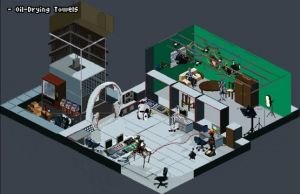 The studio where ANDROIDS is made is drawn in a very pixelated style in bright colors. It’s presented in third-person mode in much the same way as Sanitarium and many RPGs are presented, with an isometric camera view from high up showing the action. The only other location SM4-SH can visit is the surface of the planet, where some crates and a broadcasting tower stand. Fanbots is rather unique in the fact that it doesn’t use music or voice acting and there is only one sound effect: the lift going up and down. Other sound effects are merely described as text on screen, as is the communication between robots.
The studio where ANDROIDS is made is drawn in a very pixelated style in bright colors. It’s presented in third-person mode in much the same way as Sanitarium and many RPGs are presented, with an isometric camera view from high up showing the action. The only other location SM4-SH can visit is the surface of the planet, where some crates and a broadcasting tower stand. Fanbots is rather unique in the fact that it doesn’t use music or voice acting and there is only one sound effect: the lift going up and down. Other sound effects are merely described as text on screen, as is the communication between robots.
The game is mouse-driven, with the left button interacting with things and the right button bringing up a short description of them. There is no way to save the game and no inventory to speak of. The puzzles are of a mixed nature: SM4-SH has to make sure the other robots can keep working, and they come with different kinds of requests. There are a few errands to run, some machinery to tinker with, and you even have to puzzle a bit to get a good script together. Fanbots is short but sweet, has many funny jokes concerning robots, nerds and sitcoms, and the ending is very satisfying. It will take you only about 15 minutes to finish so it’s worth a try.
Fanbots can be downloaded from the Adventure Game Studio.
Smells Like Art
Bosko has inherited a very dirty and stinky restroom from his great great grandpa’s neighbor. Before he can do anything with it, it has to be thoroughly cleaned. But it’s so enormously disgusting inside that even the cleaning agency refuses to help him. Bosko wants to turn the place into a restaurant, but his business advisor Lloyd convinces him that no one would eat there because he will never totally get rid of the smell. Bosko should instead turn it into an art gallery, Lloyd tells him. So Bosko goes to work, but turning the piece of germ-ridden filth he has inherited into an art gallery is going to take some effort.
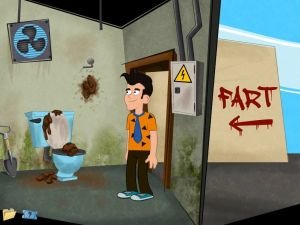 Smells Like Art, as with all Carmel Games adventures, is presented in third-person view. The screens are drawn in the familiar cartoony style in which almost no two lines are parallel. The game world, consisting of Bosko’s horrible place, a restaurant, a pet sematary (sic) and the City Hall, among others, is drawn in simple lines in cheerful hues. In the background a part of Paul Dukas’s “The Sorcerer’s Apprentice” is played ad infinitum. Luckily it can be switched off. As always, the voice acting in Smells Like Art is excellent, with each character having its own voice and accent. The spoken text is also displayed in subtitles at the top of the screen in one of the seven languages you can choose from before starting the game. The few sound effects, like filling a bucket with caramel and opening doors, are adequate.
Smells Like Art, as with all Carmel Games adventures, is presented in third-person view. The screens are drawn in the familiar cartoony style in which almost no two lines are parallel. The game world, consisting of Bosko’s horrible place, a restaurant, a pet sematary (sic) and the City Hall, among others, is drawn in simple lines in cheerful hues. In the background a part of Paul Dukas’s “The Sorcerer’s Apprentice” is played ad infinitum. Luckily it can be switched off. As always, the voice acting in Smells Like Art is excellent, with each character having its own voice and accent. The spoken text is also displayed in subtitles at the top of the screen in one of the seven languages you can choose from before starting the game. The few sound effects, like filling a bucket with caramel and opening doors, are adequate.
The interface is very intuitive, as Smells Like Art is played entirely using the left mouse button. The inventory is at the bottom right of the screen, and the game’s menu and walkthrough can be accessed via icons in the lower left corner of the screen. Bosko has to solve mainly simple inventory puzzles. He also has to find out why the owner of the only local restaurant is crying. Overall, this is one of the simpler titles by Carmel Games, but it makes for a fun ten minutes.
Smells Like Art can be played online at Kongregate.
White is More Dead: Episode I
Detective Pigeonmoche gets a new case, in which he must investigate the murder of a pipe-maker named Hector. The murder weapon was a tin whistle, and the victim’s shoes are missing. A black substance is smeared on the victim’s mailbox. Stumped, Pigeonmoche goes back to his office and asks for the help of his friend Chef Georges. Together they solve the case of the shoe-stealing murderer.
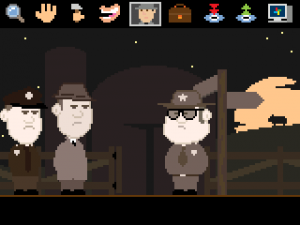 White is More Dead: Episode I, by Ludovic C. (aka chefgeorges), is drawn in a distinct pixel art style. The first half, which plays mostly in the daytime, is drawn in bright colors but the second half at night looks predictably darker and much less vibrant. Everybody you encounter, including the two protagonists, have small bodies and enormous heads, and the whole game has a comic look about it. Most of the game takes place outside at locations including a farm, a villa and a newspaper office. Cheerful jazzy music accompanies the investigation, which has no voices or sound effects. All text is displayed on screen.
White is More Dead: Episode I, by Ludovic C. (aka chefgeorges), is drawn in a distinct pixel art style. The first half, which plays mostly in the daytime, is drawn in bright colors but the second half at night looks predictably darker and much less vibrant. Everybody you encounter, including the two protagonists, have small bodies and enormous heads, and the whole game has a comic look about it. Most of the game takes place outside at locations including a farm, a villa and a newspaper office. Cheerful jazzy music accompanies the investigation, which has no voices or sound effects. All text is displayed on screen.
The cursor can be cycled using the right mouse button between a walk icon and the inventory item you are currently carrying. At the top of the screen are other commands like grab, use and talk, which you can only access by clicking them directly. The inventory is displayed at the bottom of the screen, as are text choices you can choose from during conversations. The puzzles are a mixed lot of basic inventory challenges and some interesting conversational puzzles. The latter are well constructed but fairly difficult due to translation issues. The game was originally designed in French, and the translation is sometimes so bad that I found it impossible to make out what the characters were talking about. Luckily the choices you have to make during conversations are all perfectly understandable. The script is also sprinkled with funny jokes, so despite the language flaws it’s certainly not a badly written game. There are a few loose ends, but I guess we will find out about them in the next episode.
(Note: Some people, including me, have had trouble running the introductory video that comes with the game. You can run the file directly from the game directory using a suitable video player, but it doesn’t contain any information that is essential for completing the game.)
White is More Dead: Episode I can be downloaded from the Adventure Game Studio.
Cauchemarionto
You gain consciousness and find yourself in a strange room between dimensions with two doors leading out. On a cupboard stands a talking plant who bluntly tells you that you look like a fridge and that you have to open a door to get out. You manage to open one of the doors and stumble upon a dead body. Not knowing what to do with it, you press on, trying to find someone who can tell you who and what you are. Eventually you learn your name, and that you have been used as a pawn in a terrible war.
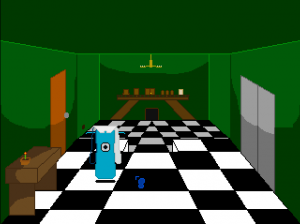 The third-person game world of vladeK’s Cauchemarionto, which consists of a number of small island-like areas, a few rooms and the shore of a lake, is presented in simple, minimalistic screens. Most of the characters are drawn in bright colors using only a few straight lines, with square heads and oblique bodies, and triangles for arms and legs. The titular protagonist does indeed look like a refrigerator with small pointed legs, one big eye on his ‘chest’ and two dog-ear-like things that could be arms hanging on both his sides. In contrast to the colorful characters, the environmental palette is drab and sombre. Strange electronic music plays continuously throughout, with a different tune at each location. No voices or sound effects can be heard. All dialogue is shown on screen as text in bright, colored letters.
The third-person game world of vladeK’s Cauchemarionto, which consists of a number of small island-like areas, a few rooms and the shore of a lake, is presented in simple, minimalistic screens. Most of the characters are drawn in bright colors using only a few straight lines, with square heads and oblique bodies, and triangles for arms and legs. The titular protagonist does indeed look like a refrigerator with small pointed legs, one big eye on his ‘chest’ and two dog-ear-like things that could be arms hanging on both his sides. In contrast to the colorful characters, the environmental palette is drab and sombre. Strange electronic music plays continuously throughout, with a different tune at each location. No voices or sound effects can be heard. All dialogue is shown on screen as text in bright, colored letters.
Cauchemarionto is played using the mouse. The left mouse button interacts, while the right button cycles through the different cursor options like talk, grab, etc. and uses the current inventory item you carry. Moving the cursor to the top of the screen makes a bar appear from which you can choose the same commands, as well as access the inventory. The few puzzles you’ll face are inventory-based and not hard. This game is more about the very bizarre and slightly intriguing story. As the mysterious protagonist, you have to put up with quite a lot of weird stuff. Everyone you meet is being tortured or dying, you must run errands for a man-like being in a black coat, and you don’t learn much about yourself from the beings you speak to. The ending is not at all what you might expect, but it gives rise to some interesting questions. If you like a game with a few dark subjects to think about after finishing, then this one is for you. It is not suitable for children because it deals with such adult-oriented themes as questions of identity, death and torture.
Cauchemarionto can be downloaded from the Adventure Game Studio.
Steve's Selections
You’re Grounded!
For quite a while now your mother has grown tired of you breaking household items with your experiments. When she catches you messing around with the washing machine, she has had enough. You’re grounded and confined to your room. But at that moment a future you arrives with terrible news. In five minutes a bomb will go off that will obliterate the town, including your house. Fortunately, future you brought plans for a device to stop it, and grants you free use of the time machine. But you are only able to transport yourself within those five minutes, and with only what is in your room to work with, can you avert disaster?
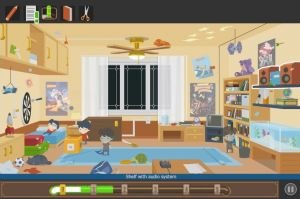 With You’re Grounded!, RANDOM games have taken their time travel premise and made as much use of it as they can. The graphics are done in a mildly cartoonish style, with a lot of bright colours. With the entire game set in a single location, a lot needed to be fitted into a small space, and there is plenty of detail. Some items lay scattered on the floor, whilst others can be found on shelves or in cupboards. You also have a couple of pets who act on their own, though you can influence their behaviour. All of these are smoothly animated. The soundtrack is a lively tune that speeds up as your time runs out. There are also plentiful sound effects, the most common being the electrical fizz of the time machine operating.
With You’re Grounded!, RANDOM games have taken their time travel premise and made as much use of it as they can. The graphics are done in a mildly cartoonish style, with a lot of bright colours. With the entire game set in a single location, a lot needed to be fitted into a small space, and there is plenty of detail. Some items lay scattered on the floor, whilst others can be found on shelves or in cupboards. You also have a couple of pets who act on their own, though you can influence their behaviour. All of these are smoothly animated. The soundtrack is a lively tune that speeds up as your time runs out. There are also plentiful sound effects, the most common being the electrical fizz of the time machine operating.
You will need to search the room thoroughly for the items you need. Control is handled by a simple left-click, with inventory objects combined by clicking each in turn. Time travel is as simple as clicking the timeline at the bottom of the screen. You can only go into the past and only back to the point that you received the device. Travelling in time means that there is now more than one of you in that time period. As you travel back again and again, you will hear the whoosh of the arrival and departure of your previous incarnations. To avoid confusion, only your current incarnation is coloured, with all previous yous appearing in black and white. Taking advantage of these multiple versions of yourself is key, as there are some tasks that current you is unable to do alone. There are also a couple of events that occur which are outside your control, but which can be used to your advantage by travelling back to that point.
You’re Grounded! can be played online at Newgrounds
Don’t Escape 3
Waking up in an airlock with the outer door about to open is not a good position to be in. Frantic work on the controls cancels the countdown and allows you access back into the ship, but there you discover horrible scenes, with all of the crew brutally murdered in various ways. With no clear recollection of events, it seems that your only hope is to flee this place before you too are killed. But as your search uncovers more about the recent past, things might not be quite as they seem. Perhaps your first instinct is not one you should be following.
 The latest instalment in scriptwelder’s counterintuitive series, Don’t Escape 3 takes horror out into space. The presentation is first-person slideshow, with a semi-realistic graphical style. From the airlock you will travel to engineering, initially filled with poisonous fumes, and a room with lighting that only flashes briefly. Animation is limited to such environmental cues, though there is little else on board that could move anyway. The corridors echo to the sound of your lone footsteps, and machinery makes appropriate noises. The music has no real tune, opting instead for a series of low tones that add to the uncomfortable atmosphere.
The latest instalment in scriptwelder’s counterintuitive series, Don’t Escape 3 takes horror out into space. The presentation is first-person slideshow, with a semi-realistic graphical style. From the airlock you will travel to engineering, initially filled with poisonous fumes, and a room with lighting that only flashes briefly. Animation is limited to such environmental cues, though there is little else on board that could move anyway. The corridors echo to the sound of your lone footsteps, and machinery makes appropriate noises. The music has no real tune, opting instead for a series of low tones that add to the uncomfortable atmosphere.
This is not a game for the young or faint-hearted. The initial puzzle to escape the airlock is comparatively simple, with the timer quite generous for the actions required. After that exploration is key, with a simple one-click interface for actions. You carry a PDA, which has a plan of the ship on it showing your current location and also stores logs you find. This is accessed from a button on-screen. Your inventory is displayed across the top of the screen, from which you can select items for use. Some actions take large amounts of in-game time, so you will be given a chance to abort when you start such an action. You must repair machinery to extend life-support, mix chemical formulas and retrieve data. There are several endings available, depending on how much you discover of the story and what you do about those discoveries.
Don’t Escape 3 is available online at Armor Games.
Tainted Olive: Chapter 2
Freelance adventurer Silvian thought his luck had changed. The job that came his way just as he needed money for his gambling debts seemed like a godsend. But now he finds himself in possession of a magical gem and embroiled in troubles far greater than himself. It appears the disruption to olive shipments was only the start. Now trade caravans are being waylaid by bandits with the power to penetrate magical armour. If he can just make it past the mountains, then maybe he will be able to find safety. The path is a treacherous one though, and the bandits are on the watch for him.
 This game is the second instalment in a planned six-part series from Black Olive Games. Having fled his home city in the first episode, Tainted Olive: Chapter 2 begins with the protagonist travelling through the Woods of Unrest. The introductory cutscene is presented through a black and white comic strip, with the game itself in full colour. Whilst not greatly detailed, shading gives the unanimated scenes some depth. The initial location involves seeing a lot of trees, but you will later find an apparently abandoned hut and enter a dark cave system. A slow piece with a heavy drumbeat provides the background for most of the action, but this is replaced by more dramatic music when danger beckons.
This game is the second instalment in a planned six-part series from Black Olive Games. Having fled his home city in the first episode, Tainted Olive: Chapter 2 begins with the protagonist travelling through the Woods of Unrest. The introductory cutscene is presented through a black and white comic strip, with the game itself in full colour. Whilst not greatly detailed, shading gives the unanimated scenes some depth. The initial location involves seeing a lot of trees, but you will later find an apparently abandoned hut and enter a dark cave system. A slow piece with a heavy drumbeat provides the background for most of the action, but this is replaced by more dramatic music when danger beckons.
It is highly recommended that you play the series’ first chapter before undertaking this one. This will not only fill in the story so far, but will provide insight into the powers of the magic stone you hold. These prove invaluable over the course of the game, though you will still need to use your wits. Control is by simple point-and-click, with movement between scenes accomplished by clicking on-screen arrows. The cursor is in the shape of the hero’s pointing hand, and glows when pointed at hotspots. Inventory sits at the bottom of the screen, along with a scroll. This represents a map of the area that can be opened and used to jump to major story locations once you have visited them. You will need to pass through a maze twice, the second time with bandits blocking some of the paths. A magic recipe is also called for, and the skills of your profession come in handy during a creative lock-picking puzzle.
Tainted Olive: Chapter 2 can be played online at JayIsGames.
DELETE?
Zai, a young boy, wakes up to find himself all alone in his apartment. Heading out to investigate he encounters a girl who tries to prevent him leaving. When he refuses to comply with her wishes, she elects to accompany him on his journey. Zai soon discovers that the apartment is contained within a scientific research facility, and his new companion is an entirely artificial being. When it becomes apparent that he too may be artificial, his quest becomes one of finding out why he has no memory of this. But is this a secret he really wants to uncover?
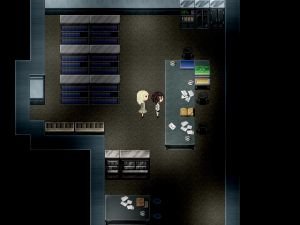 In DELETE?, Jestereir has made a character-driven science fiction game. The presentation is a top-down view reminiscent of old-style role-playing games. The opening location looks like an ordinary home with bookshelves and beds. Once outside this area, the majority of the building has more of a laboratory look, with austere tiled floors and high-tech doors. The characters are slightly stylised in normal play, though realistic full-body close-ups are shown in conversation and slideshow cutscenes. Animation is limited to the characters themselves, with other actions being accomplished during a fade to black. The background music is made up of eerie xylophone and piano pieces with limited percussion that evoke the appropriate feeling for the abandoned setting.
In DELETE?, Jestereir has made a character-driven science fiction game. The presentation is a top-down view reminiscent of old-style role-playing games. The opening location looks like an ordinary home with bookshelves and beds. Once outside this area, the majority of the building has more of a laboratory look, with austere tiled floors and high-tech doors. The characters are slightly stylised in normal play, though realistic full-body close-ups are shown in conversation and slideshow cutscenes. Animation is limited to the characters themselves, with other actions being accomplished during a fade to black. The background music is made up of eerie xylophone and piano pieces with limited percussion that evoke the appropriate feeling for the abandoned setting.
In your quest for identity, keyboard controls are used to move around, with Z used to interact with whatever you are facing. Escape brings up a menu, including your inventory and the save game system. You will want to interact with as many things as possible, as both information and inventory items are scattered around the building. Initially some parts of the laboratory are sealed off, and working out the access codes to progress forms the main objective. On one brief occasion you will also need to move quickly to avoid some hostile machinery; failing in this will result in a game over. There are four different endings available, and achieving the best of these will require paying careful attention to hints in dialogue and doing some backtracking.
DELETE? can be downloaded from GameJolt.
Once Upon a Timeline
When her regular letters stop coming, you decide to pay a visit to your scientist aunt. But much to your dismay, you arrive to find that she has been shot dead. Fearing for your own well-being when others approach the door soon after, you hide in a strange capsule in the corner of the room. As luck would have it, this capsule is the culmination of your aunt’s research, a working time machine. Able to move forward into the future and back into the past, perhaps you can avert your aunt’s unfortunate demise.
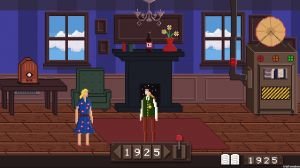 Though the second game this month to have a time machine in a single room, awfindlay’s Once Upon a Timeline takes a different approach. Instead of being confined to a short period, you are able to move back and forth through time for a span of 150 years. Though your physical location is unchanged, the appearance varies significantly over that time. The pixel art graphics are fairly blocky, but the backgrounds display enough detail to identify objects. From the woods in which the house was originally built, you progress through various redecorations and eventually see it crumble away. Travel through time is accompanied by a suitable science fiction sound effect. A slow tonal sci-fi tune also plays in the background.
Though the second game this month to have a time machine in a single room, awfindlay’s Once Upon a Timeline takes a different approach. Instead of being confined to a short period, you are able to move back and forth through time for a span of 150 years. Though your physical location is unchanged, the appearance varies significantly over that time. The pixel art graphics are fairly blocky, but the backgrounds display enough detail to identify objects. From the woods in which the house was originally built, you progress through various redecorations and eventually see it crumble away. Travel through time is accompanied by a suitable science fiction sound effect. A slow tonal sci-fi tune also plays in the background.
Control occurs with a single-click. When in the time machine, a dial with a lever appears. Clicking on-screen buttons counts up and down in whole years, with the count rapidly speeding up if you hold the buttons down. Clicking on the lever then sends you on your journey, with the changes between your start and end date flickering past. You will need to retrieve items from both past and future, as well as alter events in the timeline. When you discover something new, it is recorded in a notebook, accessible from an on-screen representation. In addition to recording what you have discovered, this hints at what you need to do next. Examining items and people in various periods can also elicit ideas from the player character. There is a small amount of inventory gathered, but this is used automatically when appropriate.
Once Upon a Timeline can be found on GameJolt, either to be played online or downloaded for Windows, Mac, or Linux.
Other new releases
Not all games are created equal, and freeware games especially come in all shapes and sizes. Not to be overlooked, the following list might also be of interest, though these games may be significantly shorter or less polished, more experimental titles than those detailed above, some perhaps only borderline adventures to begin with.
The Hollow by Out of the Loop – When his daughter goes missing, a hunter must delve into the forbidden woods, realm of the mystical Hollow Queen.
2034 AC (After Canada) 2 by Ponch – Join Mountie Paige Rowsdower again in a game with some raunchy scenes.
The Taking of Sarah Grace by LordWill753 – Discover what horrible things happened in an old house many years ago in this text adventure.
Lucid Lucy by kalinascope – Find out what Lucy is subconsciously thinking in this very short and psychedelic game.
Indefinite by BrandLibel – You are interrogated about "The Incident", a catastrophic global event in which many world leaders were killed.
Frankie & Stein by arty-farty and Darkmetroidomega – Craft the perfect monster as a companion for a young girl.
Throw Me in the River by Reis Mahnic – A dying 80-year-old man contemplates his life.
That’s it for this month. Think we’ve missed a gem or want to tell us about your own game? Then pop in to our Adventure forum and tell us about it!
Article written by Stephen Brown and Willem Tjerkstra.




